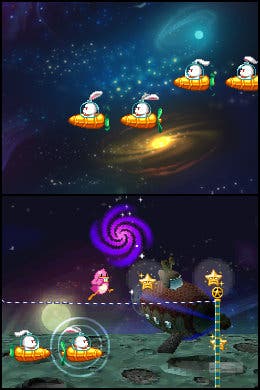Maestro: Jump In Music
Whatever that means.
After every four songs you land in a boss battle, wherein you play a game of Simon Says with a giant spider whose minions play out simple beats on his enormous web and a pair of drums. This is the most tedious portion of the game by far - it's like a particularly uncomplicated child's toy, making you repeat boring patterns over and over again until the spider's health bar is depleted. It's insultingly easy - in fact, much of the game seems that way at first. You need to get 85 per cent on a level to progress, and it'll never take more than two attempts.
That is, at least, until you finish your first runthrough of the game and discover that the entire thing was essentially a tutorial, only letting you play snatches of songs rather than the full things, and patronising you a little with hand-holding example levels for quite self-evident mechanics. Once you've beaten the final spiderboss and seen the conclusion to the cute but entirely irrelevant plot, Normal and Hard modes suddenly open up. Not only do you get the full songs, you also get a decent level of challenge. Like most rhythm-action games, Maestro gets better as it gets harder and your actions translate more directly into sounds.
It's a very odd decision to hide the content of the game from the player this way - it makes sense to offer an extra-hard mode upon completion, but you should at least be able to choose between Easy and Normal from the start, and you should certainly be allowed to play the full songs. That first playthrough doesn't take very long - only about an hour and a half - but this is a handheld game, and that's more than enough time to get bored with playing simple, incomplete tunes. Given that Maestro gets so much better as it gets harder, it only damages itself by hiding its true colours for so long.

The other problem is that it's visually overcomplicated. Maestro's rhythm-action vocabulary is too wide, and it never quite masters it. This a genre built on visual simplicity - nuggets of light, geometric shapes, contracting circles - and Maestro disguises its note prompts as flying spiders, bits of seaweed, golden angels, pieces of fruit or gun-toting chickens, with little consistency across different levels. It distracts the eye, and you never develop that instinctive pattern-recognition that guides your fingers in everything from BeatMania to Rock Band. On harder difficulty levels it quickly becomes a confusion of scrolling sprites.
Even though it's never quite great, never as effortless as it would like to be, Maestro: Jump in Music nevertheless has a raw cartoon attractiveness and real creative spark. It's let down by its strange structuring and doesn't have Ouendan's stylistic visual punch or song selection, but it still makes me smile, and I still completed it twice. It's both a good rhythm-game and a good DS platformer, and we're rather short on both at the moment.
